LCBB4003: Structure and Culture of Marks & Spencer - Business Report
VerifiedAdded on 2023/01/09
|9
|2797
|74
Report
AI Summary
This report provides an in-depth analysis of the organisational structure and culture of Marks & Spencer (M&S), a major British retail company. It examines how M&S's flat organisational structure and culture impact its performance and employee relations. The report explores key concepts such as organisational structure, performance management, and the influence of culture on employee motivation. It delves into the application of models like Charles Handy's cultural framework (power, role, task, and person culture) and McKinsey's 7S model to assess M&S's operations. The analysis includes discussions on how these factors affect decision-making, communication, and overall business outcomes. The report emphasizes the importance of aligning organisational structure and culture to achieve strategic goals and enhance competitiveness within the retail sector. The report also emphasizes the importance of effective communication and employee relations in enhancing organisational performance.
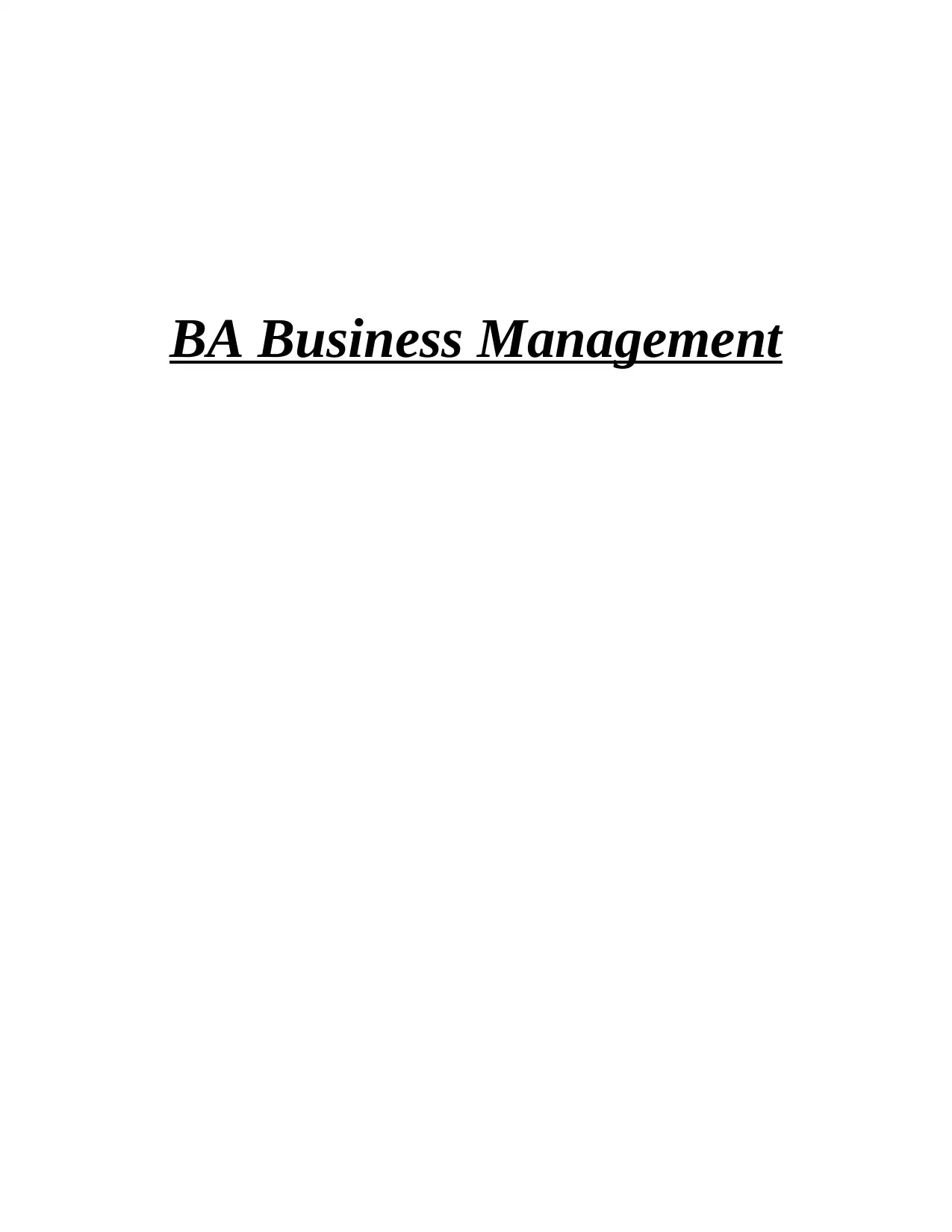
BA Business Management
Paraphrase This Document
Need a fresh take? Get an instant paraphrase of this document with our AI Paraphraser
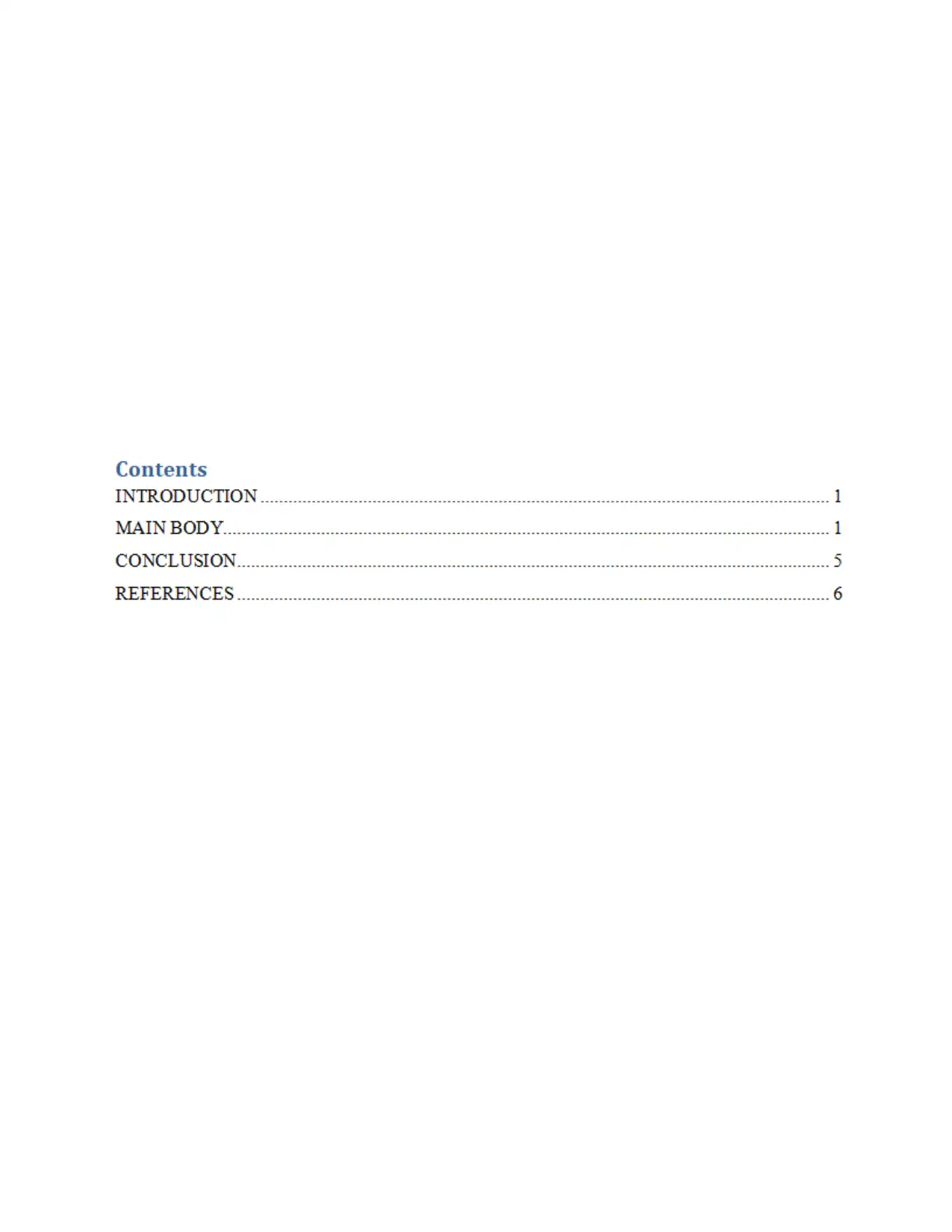
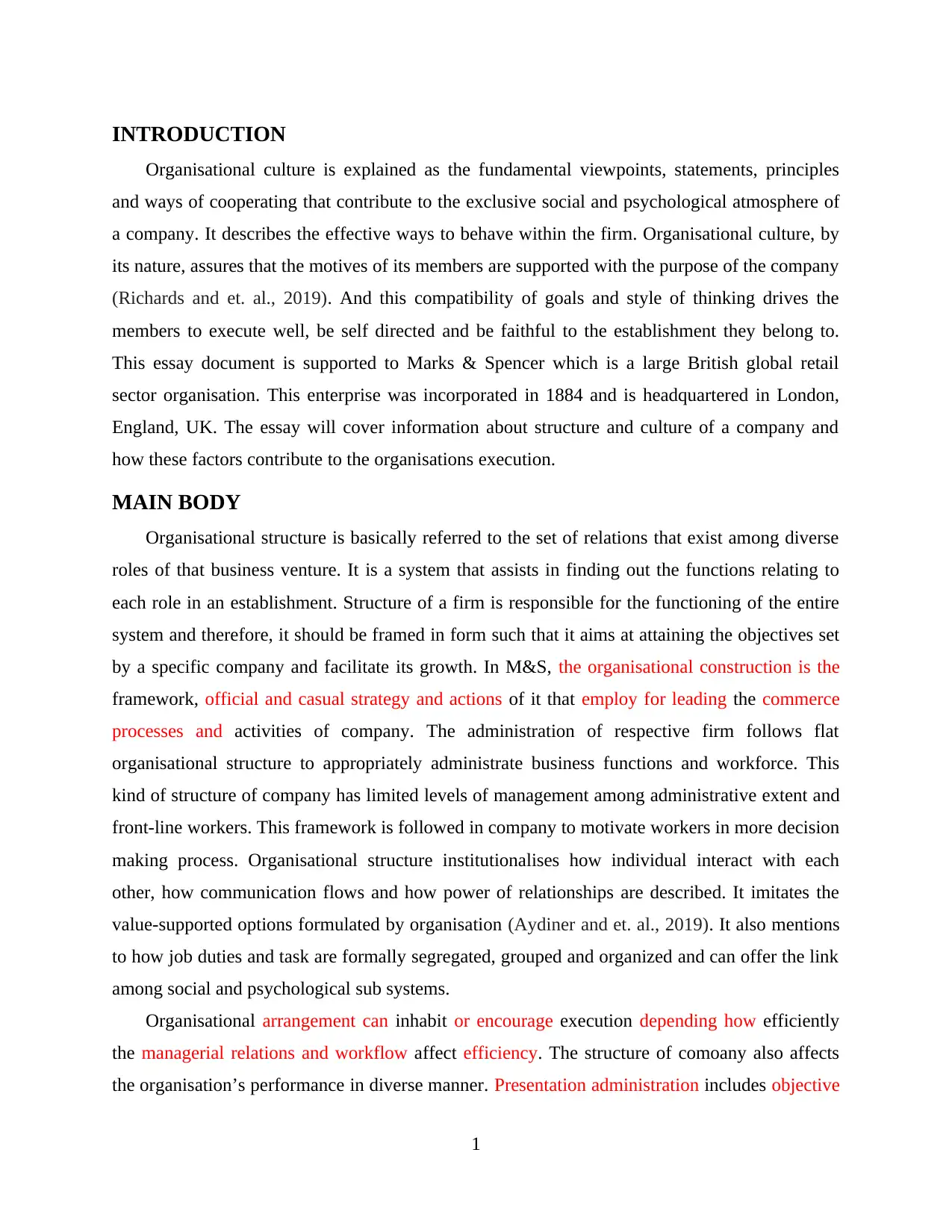
INTRODUCTION
Organisational culture is explained as the fundamental viewpoints, statements, principles
and ways of cooperating that contribute to the exclusive social and psychological atmosphere of
a company. It describes the effective ways to behave within the firm. Organisational culture, by
its nature, assures that the motives of its members are supported with the purpose of the company
(Richards and et. al., 2019). And this compatibility of goals and style of thinking drives the
members to execute well, be self directed and be faithful to the establishment they belong to.
This essay document is supported to Marks & Spencer which is a large British global retail
sector organisation. This enterprise was incorporated in 1884 and is headquartered in London,
England, UK. The essay will cover information about structure and culture of a company and
how these factors contribute to the organisations execution.
MAIN BODY
Organisational structure is basically referred to the set of relations that exist among diverse
roles of that business venture. It is a system that assists in finding out the functions relating to
each role in an establishment. Structure of a firm is responsible for the functioning of the entire
system and therefore, it should be framed in form such that it aims at attaining the objectives set
by a specific company and facilitate its growth. In M&S, the organisational construction is the
framework, official and casual strategy and actions of it that employ for leading the commerce
processes and activities of company. The administration of respective firm follows flat
organisational structure to appropriately administrate business functions and workforce. This
kind of structure of company has limited levels of management among administrative extent and
front-line workers. This framework is followed in company to motivate workers in more decision
making process. Organisational structure institutionalises how individual interact with each
other, how communication flows and how power of relationships are described. It imitates the
value-supported options formulated by organisation (Aydiner and et. al., 2019). It also mentions
to how job duties and task are formally segregated, grouped and organized and can offer the link
among social and psychological sub systems.
Organisational arrangement can inhabit or encourage execution depending how efficiently
the managerial relations and workflow affect efficiency. The structure of comoany also affects
the organisation’s performance in diverse manner. Presentation administration includes objective
1
Organisational culture is explained as the fundamental viewpoints, statements, principles
and ways of cooperating that contribute to the exclusive social and psychological atmosphere of
a company. It describes the effective ways to behave within the firm. Organisational culture, by
its nature, assures that the motives of its members are supported with the purpose of the company
(Richards and et. al., 2019). And this compatibility of goals and style of thinking drives the
members to execute well, be self directed and be faithful to the establishment they belong to.
This essay document is supported to Marks & Spencer which is a large British global retail
sector organisation. This enterprise was incorporated in 1884 and is headquartered in London,
England, UK. The essay will cover information about structure and culture of a company and
how these factors contribute to the organisations execution.
MAIN BODY
Organisational structure is basically referred to the set of relations that exist among diverse
roles of that business venture. It is a system that assists in finding out the functions relating to
each role in an establishment. Structure of a firm is responsible for the functioning of the entire
system and therefore, it should be framed in form such that it aims at attaining the objectives set
by a specific company and facilitate its growth. In M&S, the organisational construction is the
framework, official and casual strategy and actions of it that employ for leading the commerce
processes and activities of company. The administration of respective firm follows flat
organisational structure to appropriately administrate business functions and workforce. This
kind of structure of company has limited levels of management among administrative extent and
front-line workers. This framework is followed in company to motivate workers in more decision
making process. Organisational structure institutionalises how individual interact with each
other, how communication flows and how power of relationships are described. It imitates the
value-supported options formulated by organisation (Aydiner and et. al., 2019). It also mentions
to how job duties and task are formally segregated, grouped and organized and can offer the link
among social and psychological sub systems.
Organisational arrangement can inhabit or encourage execution depending how efficiently
the managerial relations and workflow affect efficiency. The structure of comoany also affects
the organisation’s performance in diverse manner. Presentation administration includes objective
1
⊘ This is a preview!⊘
Do you want full access?
Subscribe today to unlock all pages.

Trusted by 1+ million students worldwide
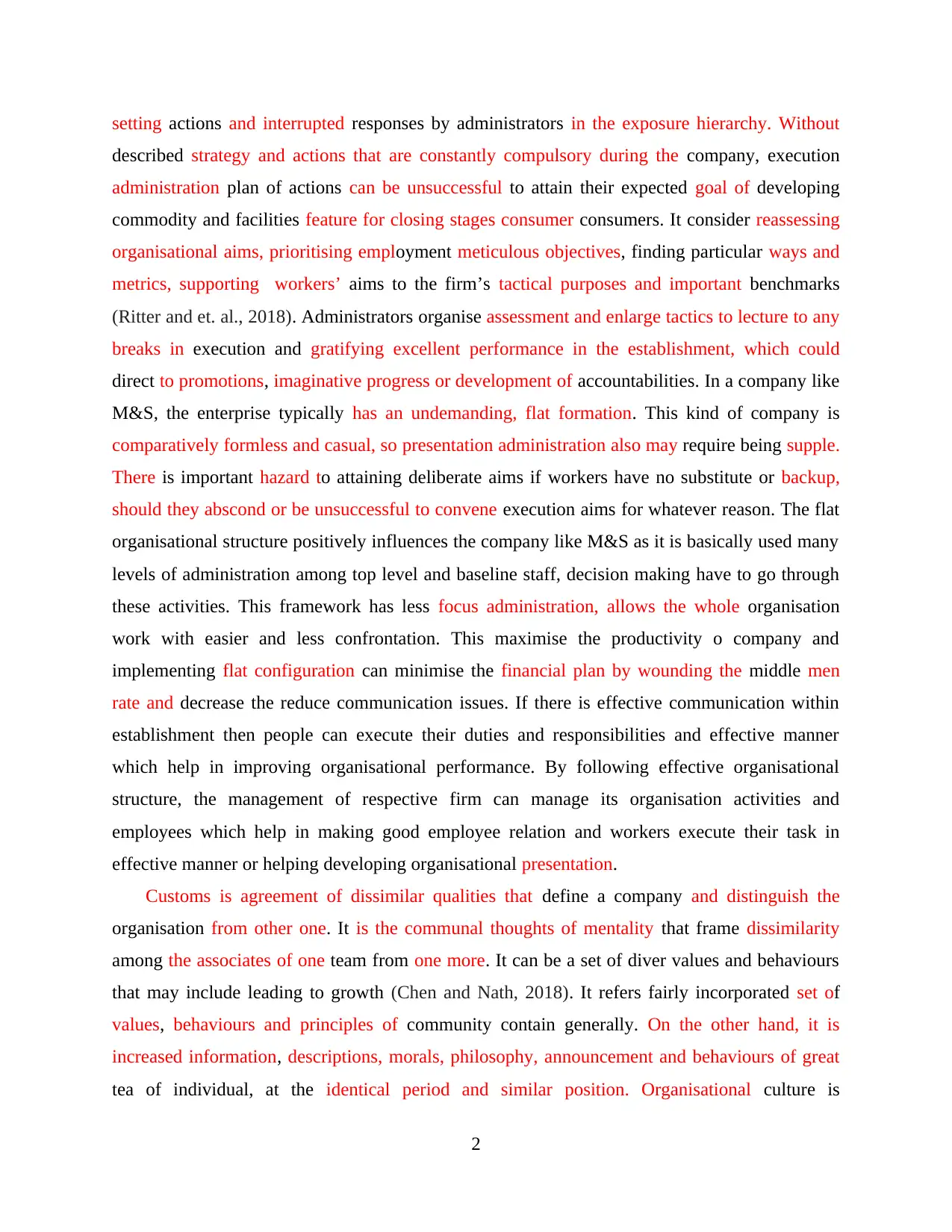
setting actions and interrupted responses by administrators in the exposure hierarchy. Without
described strategy and actions that are constantly compulsory during the company, execution
administration plan of actions can be unsuccessful to attain their expected goal of developing
commodity and facilities feature for closing stages consumer consumers. It consider reassessing
organisational aims, prioritising employment meticulous objectives, finding particular ways and
metrics, supporting workers’ aims to the firm’s tactical purposes and important benchmarks
(Ritter and et. al., 2018). Administrators organise assessment and enlarge tactics to lecture to any
breaks in execution and gratifying excellent performance in the establishment, which could
direct to promotions, imaginative progress or development of accountabilities. In a company like
M&S, the enterprise typically has an undemanding, flat formation. This kind of company is
comparatively formless and casual, so presentation administration also may require being supple.
There is important hazard to attaining deliberate aims if workers have no substitute or backup,
should they abscond or be unsuccessful to convene execution aims for whatever reason. The flat
organisational structure positively influences the company like M&S as it is basically used many
levels of administration among top level and baseline staff, decision making have to go through
these activities. This framework has less focus administration, allows the whole organisation
work with easier and less confrontation. This maximise the productivity o company and
implementing flat configuration can minimise the financial plan by wounding the middle men
rate and decrease the reduce communication issues. If there is effective communication within
establishment then people can execute their duties and responsibilities and effective manner
which help in improving organisational performance. By following effective organisational
structure, the management of respective firm can manage its organisation activities and
employees which help in making good employee relation and workers execute their task in
effective manner or helping developing organisational presentation.
Customs is agreement of dissimilar qualities that define a company and distinguish the
organisation from other one. It is the communal thoughts of mentality that frame dissimilarity
among the associates of one team from one more. It can be a set of diver values and behaviours
that may include leading to growth (Chen and Nath, 2018). It refers fairly incorporated set of
values, behaviours and principles of community contain generally. On the other hand, it is
increased information, descriptions, morals, philosophy, announcement and behaviours of great
tea of individual, at the identical period and similar position. Organisational culture is
2
described strategy and actions that are constantly compulsory during the company, execution
administration plan of actions can be unsuccessful to attain their expected goal of developing
commodity and facilities feature for closing stages consumer consumers. It consider reassessing
organisational aims, prioritising employment meticulous objectives, finding particular ways and
metrics, supporting workers’ aims to the firm’s tactical purposes and important benchmarks
(Ritter and et. al., 2018). Administrators organise assessment and enlarge tactics to lecture to any
breaks in execution and gratifying excellent performance in the establishment, which could
direct to promotions, imaginative progress or development of accountabilities. In a company like
M&S, the enterprise typically has an undemanding, flat formation. This kind of company is
comparatively formless and casual, so presentation administration also may require being supple.
There is important hazard to attaining deliberate aims if workers have no substitute or backup,
should they abscond or be unsuccessful to convene execution aims for whatever reason. The flat
organisational structure positively influences the company like M&S as it is basically used many
levels of administration among top level and baseline staff, decision making have to go through
these activities. This framework has less focus administration, allows the whole organisation
work with easier and less confrontation. This maximise the productivity o company and
implementing flat configuration can minimise the financial plan by wounding the middle men
rate and decrease the reduce communication issues. If there is effective communication within
establishment then people can execute their duties and responsibilities and effective manner
which help in improving organisational performance. By following effective organisational
structure, the management of respective firm can manage its organisation activities and
employees which help in making good employee relation and workers execute their task in
effective manner or helping developing organisational presentation.
Customs is agreement of dissimilar qualities that define a company and distinguish the
organisation from other one. It is the communal thoughts of mentality that frame dissimilarity
among the associates of one team from one more. It can be a set of diver values and behaviours
that may include leading to growth (Chen and Nath, 2018). It refers fairly incorporated set of
values, behaviours and principles of community contain generally. On the other hand, it is
increased information, descriptions, morals, philosophy, announcement and behaviours of great
tea of individual, at the identical period and similar position. Organisational culture is
2
Paraphrase This Document
Need a fresh take? Get an instant paraphrase of this document with our AI Paraphraser
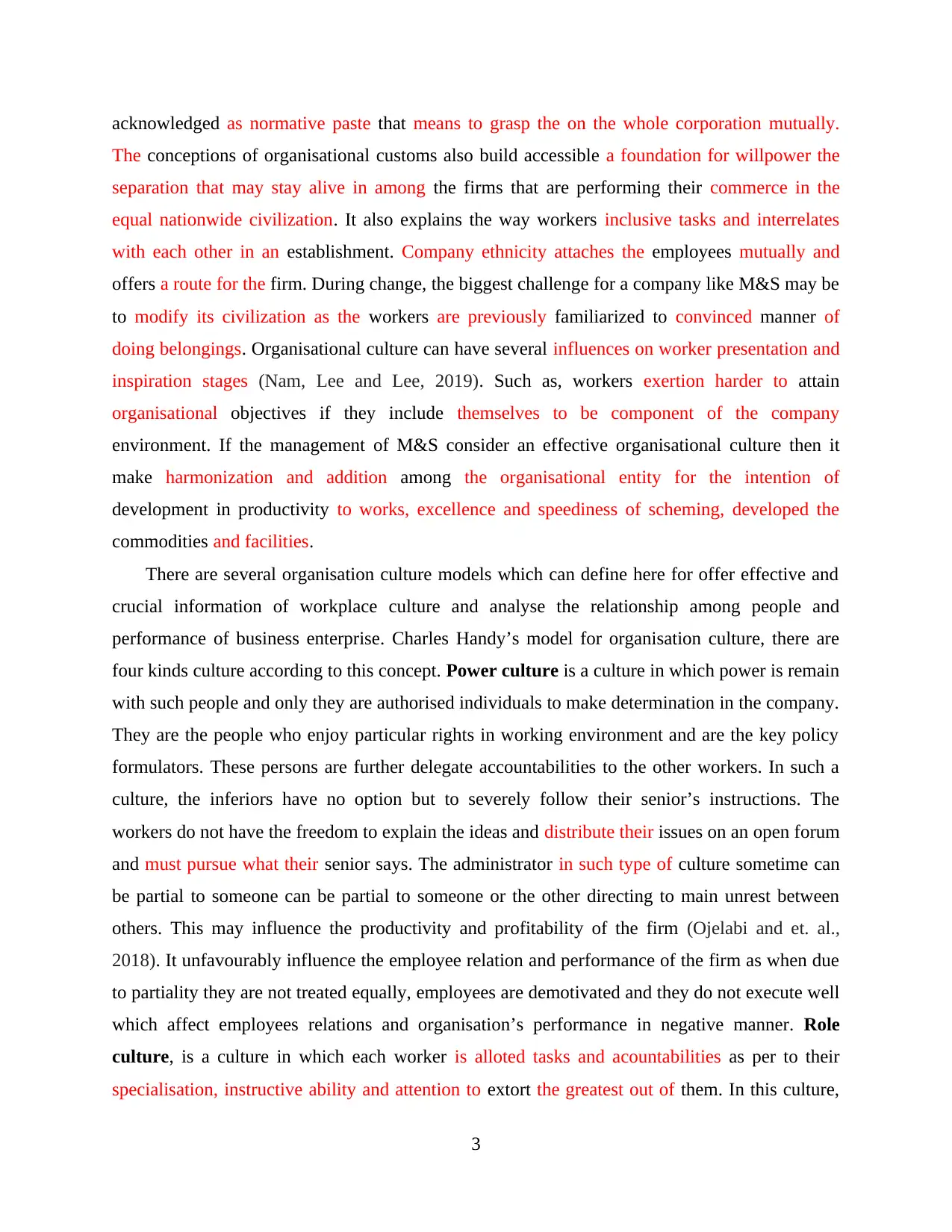
acknowledged as normative paste that means to grasp the on the whole corporation mutually.
The conceptions of organisational customs also build accessible a foundation for willpower the
separation that may stay alive in among the firms that are performing their commerce in the
equal nationwide civilization. It also explains the way workers inclusive tasks and interrelates
with each other in an establishment. Company ethnicity attaches the employees mutually and
offers a route for the firm. During change, the biggest challenge for a company like M&S may be
to modify its civilization as the workers are previously familiarized to convinced manner of
doing belongings. Organisational culture can have several influences on worker presentation and
inspiration stages (Nam, Lee and Lee, 2019). Such as, workers exertion harder to attain
organisational objectives if they include themselves to be component of the company
environment. If the management of M&S consider an effective organisational culture then it
make harmonization and addition among the organisational entity for the intention of
development in productivity to works, excellence and speediness of scheming, developed the
commodities and facilities.
There are several organisation culture models which can define here for offer effective and
crucial information of workplace culture and analyse the relationship among people and
performance of business enterprise. Charles Handy’s model for organisation culture, there are
four kinds culture according to this concept. Power culture is a culture in which power is remain
with such people and only they are authorised individuals to make determination in the company.
They are the people who enjoy particular rights in working environment and are the key policy
formulators. These persons are further delegate accountabilities to the other workers. In such a
culture, the inferiors have no option but to severely follow their senior’s instructions. The
workers do not have the freedom to explain the ideas and distribute their issues on an open forum
and must pursue what their senior says. The administrator in such type of culture sometime can
be partial to someone can be partial to someone or the other directing to main unrest between
others. This may influence the productivity and profitability of the firm (Ojelabi and et. al.,
2018). It unfavourably influence the employee relation and performance of the firm as when due
to partiality they are not treated equally, employees are demotivated and they do not execute well
which affect employees relations and organisation’s performance in negative manner. Role
culture, is a culture in which each worker is alloted tasks and acountabilities as per to their
specialisation, instructive ability and attention to extort the greatest out of them. In this culture,
3
The conceptions of organisational customs also build accessible a foundation for willpower the
separation that may stay alive in among the firms that are performing their commerce in the
equal nationwide civilization. It also explains the way workers inclusive tasks and interrelates
with each other in an establishment. Company ethnicity attaches the employees mutually and
offers a route for the firm. During change, the biggest challenge for a company like M&S may be
to modify its civilization as the workers are previously familiarized to convinced manner of
doing belongings. Organisational culture can have several influences on worker presentation and
inspiration stages (Nam, Lee and Lee, 2019). Such as, workers exertion harder to attain
organisational objectives if they include themselves to be component of the company
environment. If the management of M&S consider an effective organisational culture then it
make harmonization and addition among the organisational entity for the intention of
development in productivity to works, excellence and speediness of scheming, developed the
commodities and facilities.
There are several organisation culture models which can define here for offer effective and
crucial information of workplace culture and analyse the relationship among people and
performance of business enterprise. Charles Handy’s model for organisation culture, there are
four kinds culture according to this concept. Power culture is a culture in which power is remain
with such people and only they are authorised individuals to make determination in the company.
They are the people who enjoy particular rights in working environment and are the key policy
formulators. These persons are further delegate accountabilities to the other workers. In such a
culture, the inferiors have no option but to severely follow their senior’s instructions. The
workers do not have the freedom to explain the ideas and distribute their issues on an open forum
and must pursue what their senior says. The administrator in such type of culture sometime can
be partial to someone can be partial to someone or the other directing to main unrest between
others. This may influence the productivity and profitability of the firm (Ojelabi and et. al.,
2018). It unfavourably influence the employee relation and performance of the firm as when due
to partiality they are not treated equally, employees are demotivated and they do not execute well
which affect employees relations and organisation’s performance in negative manner. Role
culture, is a culture in which each worker is alloted tasks and acountabilities as per to their
specialisation, instructive ability and attention to extort the greatest out of them. In this culture,
3
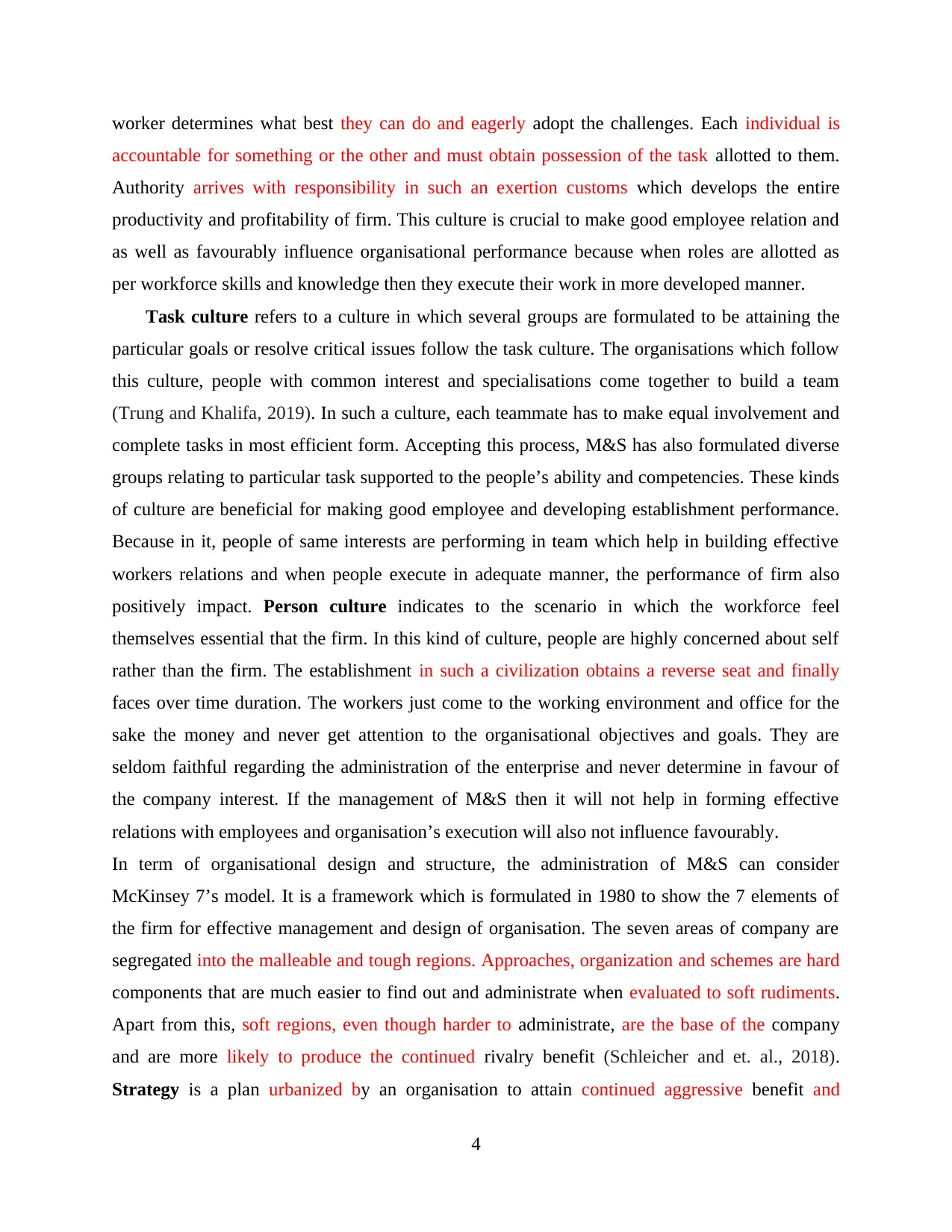
worker determines what best they can do and eagerly adopt the challenges. Each individual is
accountable for something or the other and must obtain possession of the task allotted to them.
Authority arrives with responsibility in such an exertion customs which develops the entire
productivity and profitability of firm. This culture is crucial to make good employee relation and
as well as favourably influence organisational performance because when roles are allotted as
per workforce skills and knowledge then they execute their work in more developed manner.
Task culture refers to a culture in which several groups are formulated to be attaining the
particular goals or resolve critical issues follow the task culture. The organisations which follow
this culture, people with common interest and specialisations come together to build a team
(Trung and Khalifa, 2019). In such a culture, each teammate has to make equal involvement and
complete tasks in most efficient form. Accepting this process, M&S has also formulated diverse
groups relating to particular task supported to the people’s ability and competencies. These kinds
of culture are beneficial for making good employee and developing establishment performance.
Because in it, people of same interests are performing in team which help in building effective
workers relations and when people execute in adequate manner, the performance of firm also
positively impact. Person culture indicates to the scenario in which the workforce feel
themselves essential that the firm. In this kind of culture, people are highly concerned about self
rather than the firm. The establishment in such a civilization obtains a reverse seat and finally
faces over time duration. The workers just come to the working environment and office for the
sake the money and never get attention to the organisational objectives and goals. They are
seldom faithful regarding the administration of the enterprise and never determine in favour of
the company interest. If the management of M&S then it will not help in forming effective
relations with employees and organisation’s execution will also not influence favourably.
In term of organisational design and structure, the administration of M&S can consider
McKinsey 7’s model. It is a framework which is formulated in 1980 to show the 7 elements of
the firm for effective management and design of organisation. The seven areas of company are
segregated into the malleable and tough regions. Approaches, organization and schemes are hard
components that are much easier to find out and administrate when evaluated to soft rudiments.
Apart from this, soft regions, even though harder to administrate, are the base of the company
and are more likely to produce the continued rivalry benefit (Schleicher and et. al., 2018).
Strategy is a plan urbanized by an organisation to attain continued aggressive benefit and
4
accountable for something or the other and must obtain possession of the task allotted to them.
Authority arrives with responsibility in such an exertion customs which develops the entire
productivity and profitability of firm. This culture is crucial to make good employee relation and
as well as favourably influence organisational performance because when roles are allotted as
per workforce skills and knowledge then they execute their work in more developed manner.
Task culture refers to a culture in which several groups are formulated to be attaining the
particular goals or resolve critical issues follow the task culture. The organisations which follow
this culture, people with common interest and specialisations come together to build a team
(Trung and Khalifa, 2019). In such a culture, each teammate has to make equal involvement and
complete tasks in most efficient form. Accepting this process, M&S has also formulated diverse
groups relating to particular task supported to the people’s ability and competencies. These kinds
of culture are beneficial for making good employee and developing establishment performance.
Because in it, people of same interests are performing in team which help in building effective
workers relations and when people execute in adequate manner, the performance of firm also
positively impact. Person culture indicates to the scenario in which the workforce feel
themselves essential that the firm. In this kind of culture, people are highly concerned about self
rather than the firm. The establishment in such a civilization obtains a reverse seat and finally
faces over time duration. The workers just come to the working environment and office for the
sake the money and never get attention to the organisational objectives and goals. They are
seldom faithful regarding the administration of the enterprise and never determine in favour of
the company interest. If the management of M&S then it will not help in forming effective
relations with employees and organisation’s execution will also not influence favourably.
In term of organisational design and structure, the administration of M&S can consider
McKinsey 7’s model. It is a framework which is formulated in 1980 to show the 7 elements of
the firm for effective management and design of organisation. The seven areas of company are
segregated into the malleable and tough regions. Approaches, organization and schemes are hard
components that are much easier to find out and administrate when evaluated to soft rudiments.
Apart from this, soft regions, even though harder to administrate, are the base of the company
and are more likely to produce the continued rivalry benefit (Schleicher and et. al., 2018).
Strategy is a plan urbanized by an organisation to attain continued aggressive benefit and
4
⊘ This is a preview!⊘
Do you want full access?
Subscribe today to unlock all pages.

Trusted by 1+ million students worldwide
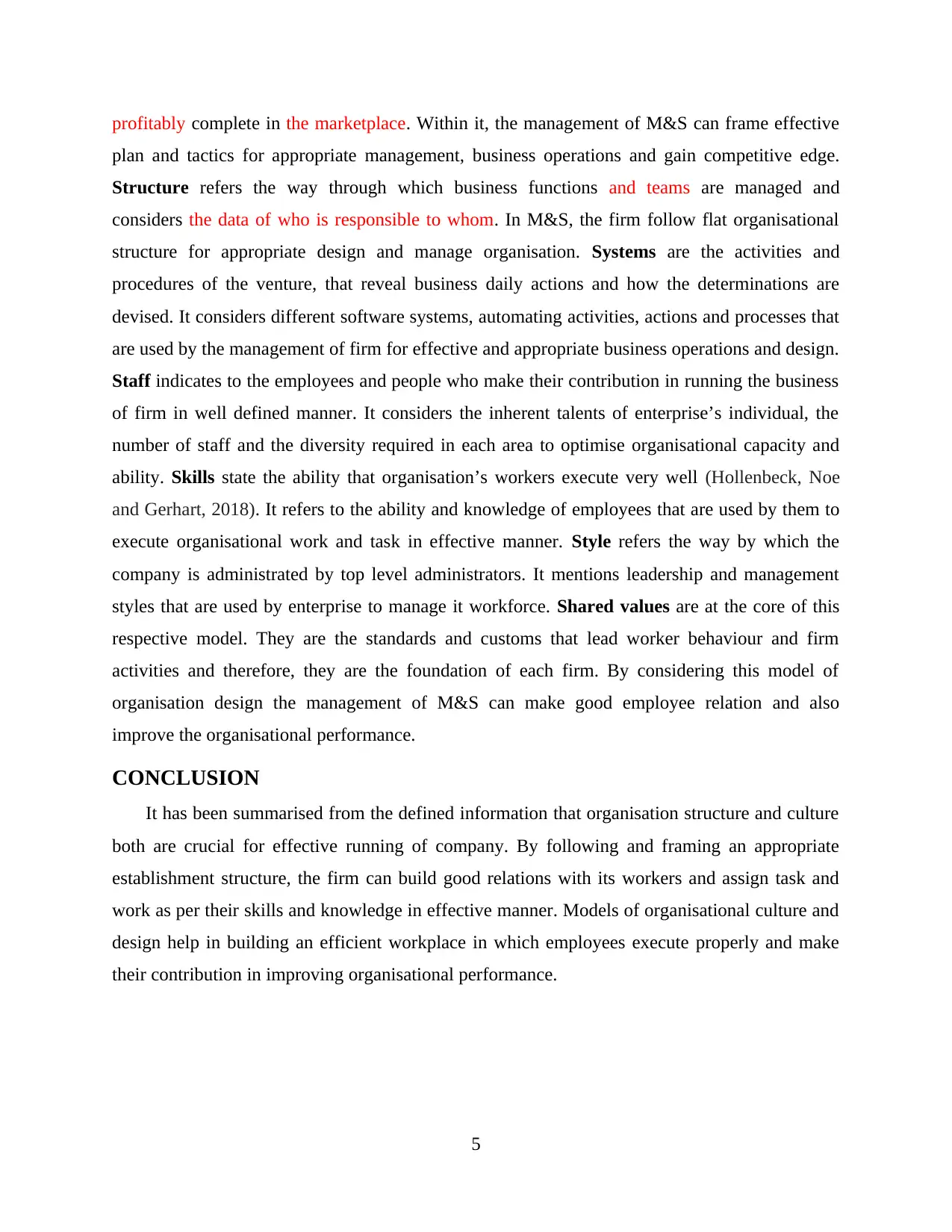
profitably complete in the marketplace. Within it, the management of M&S can frame effective
plan and tactics for appropriate management, business operations and gain competitive edge.
Structure refers the way through which business functions and teams are managed and
considers the data of who is responsible to whom. In M&S, the firm follow flat organisational
structure for appropriate design and manage organisation. Systems are the activities and
procedures of the venture, that reveal business daily actions and how the determinations are
devised. It considers different software systems, automating activities, actions and processes that
are used by the management of firm for effective and appropriate business operations and design.
Staff indicates to the employees and people who make their contribution in running the business
of firm in well defined manner. It considers the inherent talents of enterprise’s individual, the
number of staff and the diversity required in each area to optimise organisational capacity and
ability. Skills state the ability that organisation’s workers execute very well (Hollenbeck, Noe
and Gerhart, 2018). It refers to the ability and knowledge of employees that are used by them to
execute organisational work and task in effective manner. Style refers the way by which the
company is administrated by top level administrators. It mentions leadership and management
styles that are used by enterprise to manage it workforce. Shared values are at the core of this
respective model. They are the standards and customs that lead worker behaviour and firm
activities and therefore, they are the foundation of each firm. By considering this model of
organisation design the management of M&S can make good employee relation and also
improve the organisational performance.
CONCLUSION
It has been summarised from the defined information that organisation structure and culture
both are crucial for effective running of company. By following and framing an appropriate
establishment structure, the firm can build good relations with its workers and assign task and
work as per their skills and knowledge in effective manner. Models of organisational culture and
design help in building an efficient workplace in which employees execute properly and make
their contribution in improving organisational performance.
5
plan and tactics for appropriate management, business operations and gain competitive edge.
Structure refers the way through which business functions and teams are managed and
considers the data of who is responsible to whom. In M&S, the firm follow flat organisational
structure for appropriate design and manage organisation. Systems are the activities and
procedures of the venture, that reveal business daily actions and how the determinations are
devised. It considers different software systems, automating activities, actions and processes that
are used by the management of firm for effective and appropriate business operations and design.
Staff indicates to the employees and people who make their contribution in running the business
of firm in well defined manner. It considers the inherent talents of enterprise’s individual, the
number of staff and the diversity required in each area to optimise organisational capacity and
ability. Skills state the ability that organisation’s workers execute very well (Hollenbeck, Noe
and Gerhart, 2018). It refers to the ability and knowledge of employees that are used by them to
execute organisational work and task in effective manner. Style refers the way by which the
company is administrated by top level administrators. It mentions leadership and management
styles that are used by enterprise to manage it workforce. Shared values are at the core of this
respective model. They are the standards and customs that lead worker behaviour and firm
activities and therefore, they are the foundation of each firm. By considering this model of
organisation design the management of M&S can make good employee relation and also
improve the organisational performance.
CONCLUSION
It has been summarised from the defined information that organisation structure and culture
both are crucial for effective running of company. By following and framing an appropriate
establishment structure, the firm can build good relations with its workers and assign task and
work as per their skills and knowledge in effective manner. Models of organisational culture and
design help in building an efficient workplace in which employees execute properly and make
their contribution in improving organisational performance.
5
Paraphrase This Document
Need a fresh take? Get an instant paraphrase of this document with our AI Paraphraser
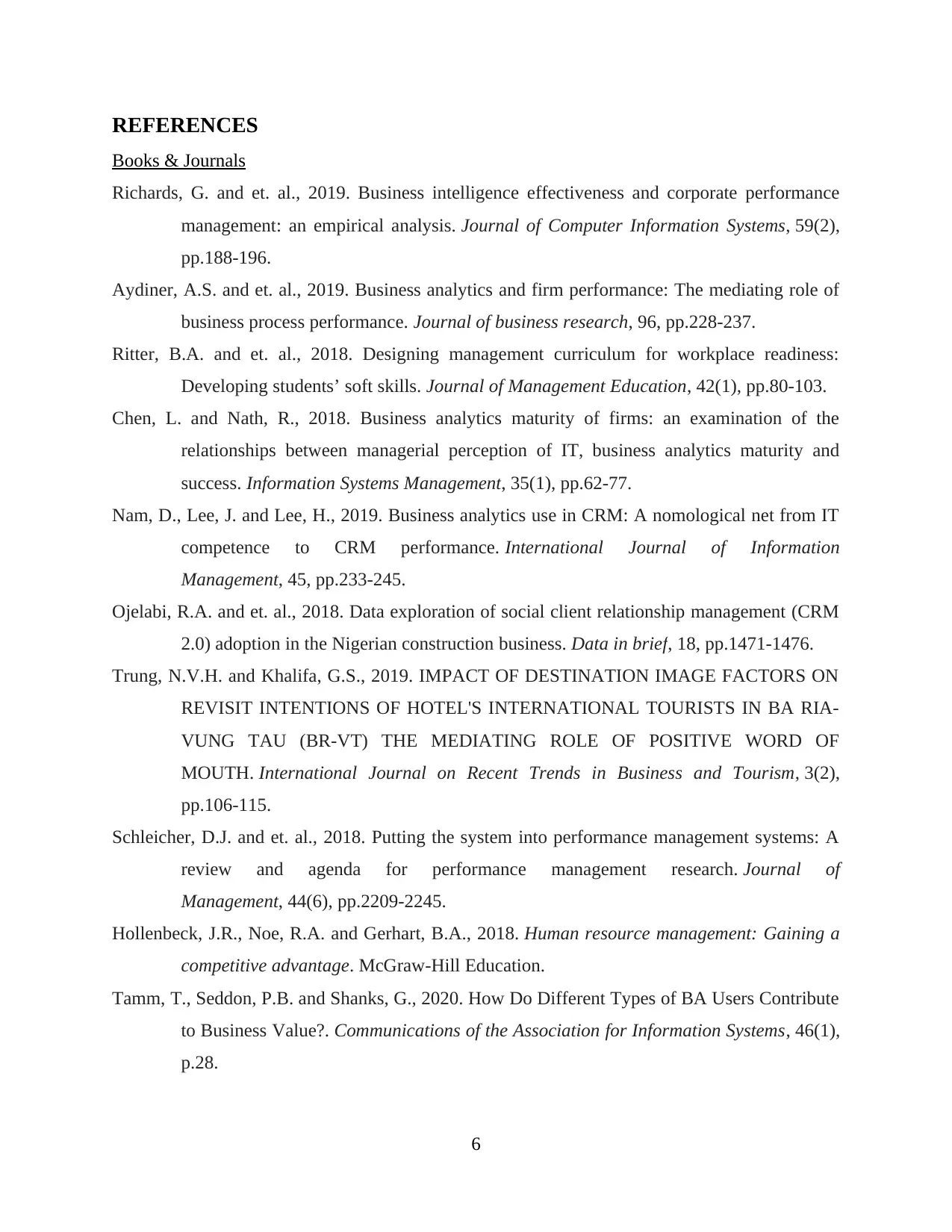
REFERENCES
Books & Journals
Richards, G. and et. al., 2019. Business intelligence effectiveness and corporate performance
management: an empirical analysis. Journal of Computer Information Systems, 59(2),
pp.188-196.
Aydiner, A.S. and et. al., 2019. Business analytics and firm performance: The mediating role of
business process performance. Journal of business research, 96, pp.228-237.
Ritter, B.A. and et. al., 2018. Designing management curriculum for workplace readiness:
Developing students’ soft skills. Journal of Management Education, 42(1), pp.80-103.
Chen, L. and Nath, R., 2018. Business analytics maturity of firms: an examination of the
relationships between managerial perception of IT, business analytics maturity and
success. Information Systems Management, 35(1), pp.62-77.
Nam, D., Lee, J. and Lee, H., 2019. Business analytics use in CRM: A nomological net from IT
competence to CRM performance. International Journal of Information
Management, 45, pp.233-245.
Ojelabi, R.A. and et. al., 2018. Data exploration of social client relationship management (CRM
2.0) adoption in the Nigerian construction business. Data in brief, 18, pp.1471-1476.
Trung, N.V.H. and Khalifa, G.S., 2019. IMPACT OF DESTINATION IMAGE FACTORS ON
REVISIT INTENTIONS OF HOTEL'S INTERNATIONAL TOURISTS IN BA RIA-
VUNG TAU (BR-VT) THE MEDIATING ROLE OF POSITIVE WORD OF
MOUTH. International Journal on Recent Trends in Business and Tourism, 3(2),
pp.106-115.
Schleicher, D.J. and et. al., 2018. Putting the system into performance management systems: A
review and agenda for performance management research. Journal of
Management, 44(6), pp.2209-2245.
Hollenbeck, J.R., Noe, R.A. and Gerhart, B.A., 2018. Human resource management: Gaining a
competitive advantage. McGraw-Hill Education.
Tamm, T., Seddon, P.B. and Shanks, G., 2020. How Do Different Types of BA Users Contribute
to Business Value?. Communications of the Association for Information Systems, 46(1),
p.28.
6
Books & Journals
Richards, G. and et. al., 2019. Business intelligence effectiveness and corporate performance
management: an empirical analysis. Journal of Computer Information Systems, 59(2),
pp.188-196.
Aydiner, A.S. and et. al., 2019. Business analytics and firm performance: The mediating role of
business process performance. Journal of business research, 96, pp.228-237.
Ritter, B.A. and et. al., 2018. Designing management curriculum for workplace readiness:
Developing students’ soft skills. Journal of Management Education, 42(1), pp.80-103.
Chen, L. and Nath, R., 2018. Business analytics maturity of firms: an examination of the
relationships between managerial perception of IT, business analytics maturity and
success. Information Systems Management, 35(1), pp.62-77.
Nam, D., Lee, J. and Lee, H., 2019. Business analytics use in CRM: A nomological net from IT
competence to CRM performance. International Journal of Information
Management, 45, pp.233-245.
Ojelabi, R.A. and et. al., 2018. Data exploration of social client relationship management (CRM
2.0) adoption in the Nigerian construction business. Data in brief, 18, pp.1471-1476.
Trung, N.V.H. and Khalifa, G.S., 2019. IMPACT OF DESTINATION IMAGE FACTORS ON
REVISIT INTENTIONS OF HOTEL'S INTERNATIONAL TOURISTS IN BA RIA-
VUNG TAU (BR-VT) THE MEDIATING ROLE OF POSITIVE WORD OF
MOUTH. International Journal on Recent Trends in Business and Tourism, 3(2),
pp.106-115.
Schleicher, D.J. and et. al., 2018. Putting the system into performance management systems: A
review and agenda for performance management research. Journal of
Management, 44(6), pp.2209-2245.
Hollenbeck, J.R., Noe, R.A. and Gerhart, B.A., 2018. Human resource management: Gaining a
competitive advantage. McGraw-Hill Education.
Tamm, T., Seddon, P.B. and Shanks, G., 2020. How Do Different Types of BA Users Contribute
to Business Value?. Communications of the Association for Information Systems, 46(1),
p.28.
6
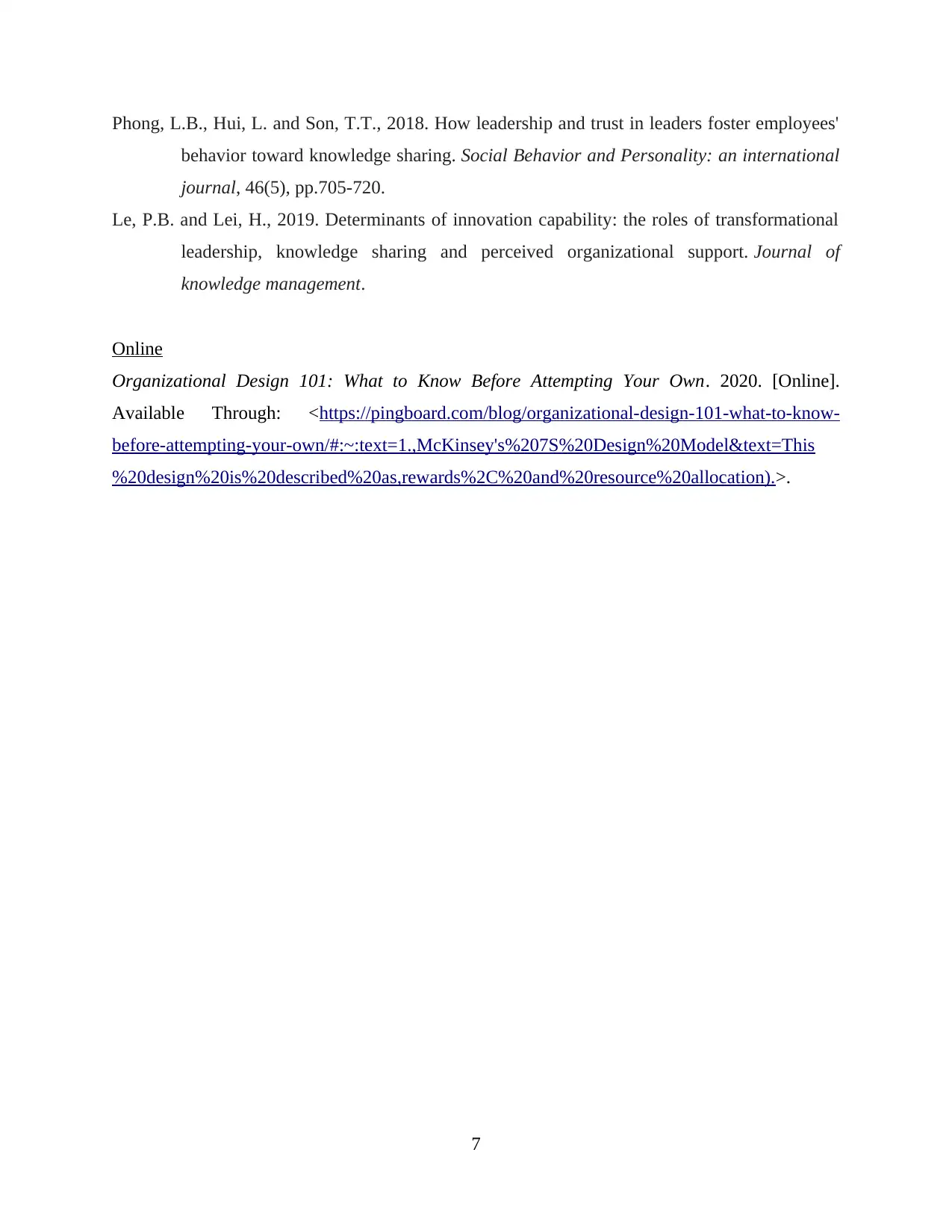
Phong, L.B., Hui, L. and Son, T.T., 2018. How leadership and trust in leaders foster employees'
behavior toward knowledge sharing. Social Behavior and Personality: an international
journal, 46(5), pp.705-720.
Le, P.B. and Lei, H., 2019. Determinants of innovation capability: the roles of transformational
leadership, knowledge sharing and perceived organizational support. Journal of
knowledge management.
Online
Organizational Design 101: What to Know Before Attempting Your Own. 2020. [Online].
Available Through: <https://pingboard.com/blog/organizational-design-101-what-to-know-
before-attempting-your-own/#:~:text=1.,McKinsey's%207S%20Design%20Model&text=This
%20design%20is%20described%20as,rewards%2C%20and%20resource%20allocation).>.
7
behavior toward knowledge sharing. Social Behavior and Personality: an international
journal, 46(5), pp.705-720.
Le, P.B. and Lei, H., 2019. Determinants of innovation capability: the roles of transformational
leadership, knowledge sharing and perceived organizational support. Journal of
knowledge management.
Online
Organizational Design 101: What to Know Before Attempting Your Own. 2020. [Online].
Available Through: <https://pingboard.com/blog/organizational-design-101-what-to-know-
before-attempting-your-own/#:~:text=1.,McKinsey's%207S%20Design%20Model&text=This
%20design%20is%20described%20as,rewards%2C%20and%20resource%20allocation).>.
7
⊘ This is a preview!⊘
Do you want full access?
Subscribe today to unlock all pages.

Trusted by 1+ million students worldwide
1 out of 9
Related Documents
Your All-in-One AI-Powered Toolkit for Academic Success.
+13062052269
info@desklib.com
Available 24*7 on WhatsApp / Email
![[object Object]](/_next/static/media/star-bottom.7253800d.svg)
Unlock your academic potential
Copyright © 2020–2025 A2Z Services. All Rights Reserved. Developed and managed by ZUCOL.





